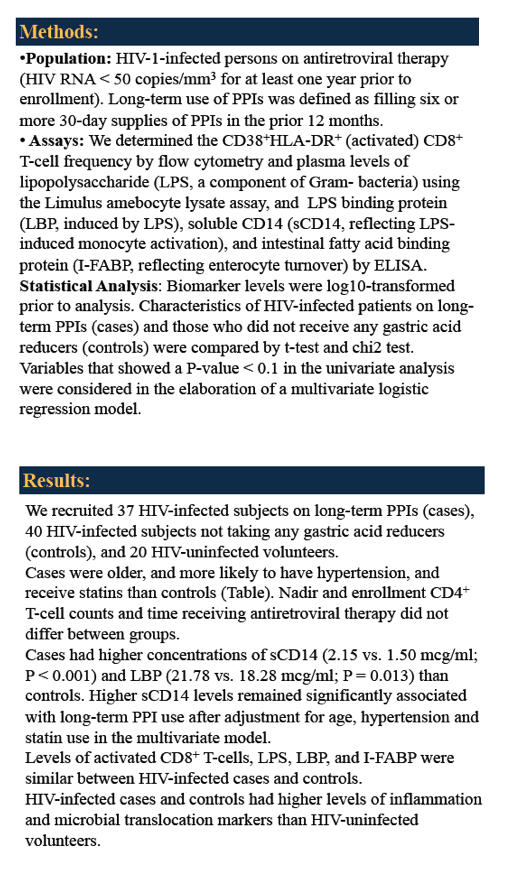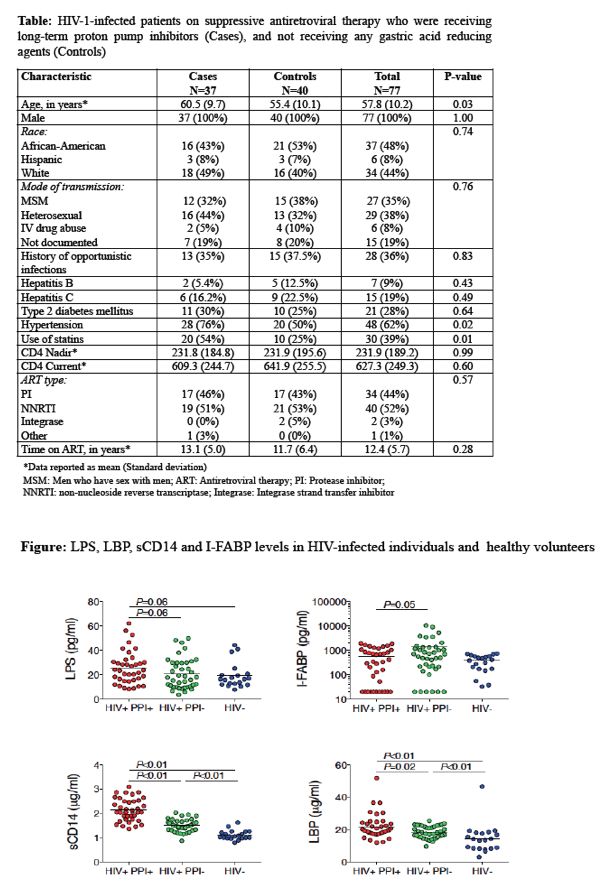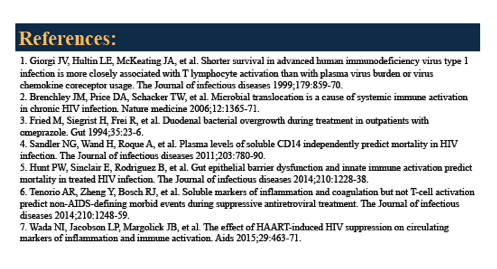 |
 |
 |
| |
Long-term use of proton pump inhibitors and increased immune activation in patients with chronic HIV-1 infection Contact Information - Caution Advised on Long-Term PPIs Because of Link to Immune Activation With HIV
|
| |
| |
IDWeek 2016, October 26-30, 2016, New Orleans
Mark Mascolini
A three-way comparison involving older men with and without HIV linked long-term proton pump inhibitor (PPI) use to higher levels of soluble CD14 (sCD14) and thus greater monocyte activation in people with HIV infection [1]. High sCD14 has been tied to poor CD4-cell gains and increased mortality in HIV-positive people.
Migration of microbes out of damaged gut--microbial translocation--is a hallmark of HIV infection that boosts systemic immune activation [2] and has been linked to a higher death risk [3]. Because they promote microbial overgrowth in the gut, PPIs could affect microbial translocation and the outcomes associated with it. Researchers from Houston's Baylor College of Medicine and collaborators from other centers conducted this study to determine whether long-term PPI use affects microbial translocation, immune activation, and inflammation in people with HIV.
The study involved (1) 37 antiretroviral-treated men with a viral load below 50 copies for at least 1 year and taking long-term PPIs, defined as 6 or more 30-day prescription refills in the past 12 months (cases), (2) 40 men with HIV taking no gastric acid reducers (controls), and (3) 20 men without HIV. In all participants, researchers measured lipopolysaccharide (LPS), LPS binding protein (LBP), sCD14 (a marker of LPS-induced monocyte activation), activated (CD38+HLA-DR+) CD8 cells, and intestinal fatty acid-binding protein (I-FABP, a marker of gut-lining cell [enterocyte] turnover).
Age averaged 60.5 years among long-term PPI cases and 55.4 among HIV-positive controls (P = 0.03). All cases and controls were men, about half were black, and about 8% Hispanic. A higher proportions of cases than controls had hypertension (76% versus 50%, P = 0.02), and a higher proportion used statins (54% versus 25%, P = 0.01). Average time on antiretroviral therapy did not differ significantly between cases and controls (13.1 and 11.7 years).
Compared with controls, the long-term PPI-using cases had significantly higher concentrations of sCD14 (2.15 versus 1.50 mcg/mL, P < 0.001) and higher concentrations of LBP (21.78 versus 18.28 mcg/mL, P = 0.013). Levels of both markers were significantly higher in cases than in the HIV-negative group (P < 0.01) and significantly higher in HIV-positive controls than in the HIV-negative group (P < 0.01). sCD14 concentrations remained significantly higher in cases than controls after statistical adjustment for age, hypertension, and statin use. Levels of activated CD8 cells did not differ significantly between cases and controls.
Higher concentrations of sCD14 and LPB in long-term PPI users suggested to the researchers that PPIs "permit increased microbial translocation, resulting in increased monocyte activation in HIV-infected individuals." Because I-FABP levels did not differ substantially between cases and controls, the investigators proposed that "enterocyte integrity is likely not disturbed by PPI use. Instead, "bacterial overgrowth or dysbiosis [microbial imbalance] may account for the increased microbial translocation and monocyte activation."
Noting that high sCD14 predicts poor CD4-cell recovery on antiretroviral therapy and a higher death risk, the Baylor team suggested that "cautious use of long-term PPIs is advised" in people with HIV infection. The researchers noted that their analysis is limited because the study population consists entirely of older male veterans.
References
1. Serpa J, Rueda AM, Somasunderam A, et al. Long-term use of proton pump inhibitors and increased immune activation in patients with chronic HIV-1 infection. IDWeek 2016, October 26-30, 2016, New Orleans. Abstract 2163.
2. Brenchley JM, Price DA, Schacker TW, et al. Microbial translocation is a cause of systemic immune activation in chronic HIV infection. Nat Med. 2006;12:1365-1371.
3. Hunt PW, Sinclair E, Rodriguez B, et al. Gut epithelial barrier dysfunction and innate immune activation predict mortality in treated HIV infection. J Infect Dis. 2014;210:1228-1238
------------------
Long-term use of proton pump inhibitors and increased immune activation in patients with chronic HIV-1 infection Contact Information
Jose A. Serpa1, Adriana M. Rueda1,2, Anoma Somasunderam3, Netanya S. Utay3, Dorothy Lewis4, Jacob P. Couturier4, Katharine G. Breaux1,2, Maria C. Rodriguez-Barradas1,2
1Section of Infectious Diseases, Department of Medicine, Baylor College of Medicine, 2Section of Infectious Diseases, Michael E. DeBakey Veterans Affairs Hospital, Houston, TX, 3Division of Infectious Diseases, Department of Medicine, University of Texas Medical Branch at Galveston, TX, 4Section of Infectious Diseases, Department of Medicine, University of Texas Health Science Center at Houston, TX





|
| |
|
 |
 |
|
|